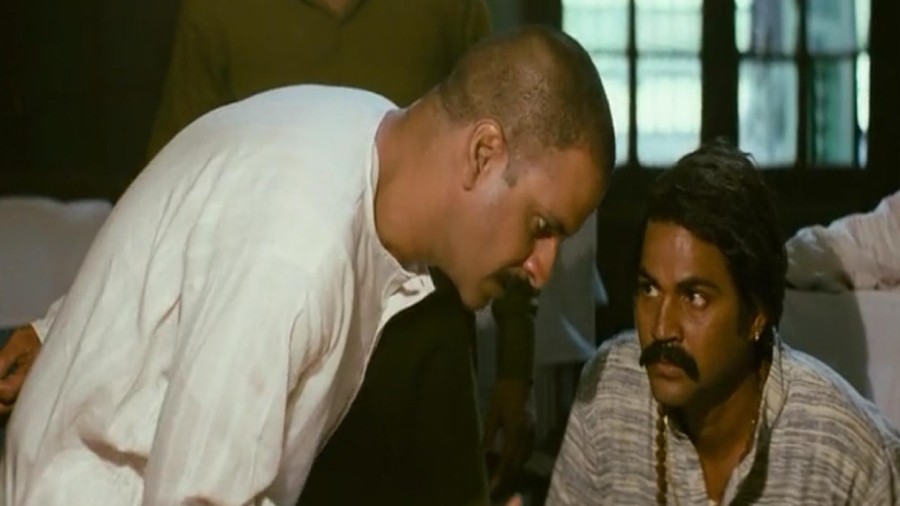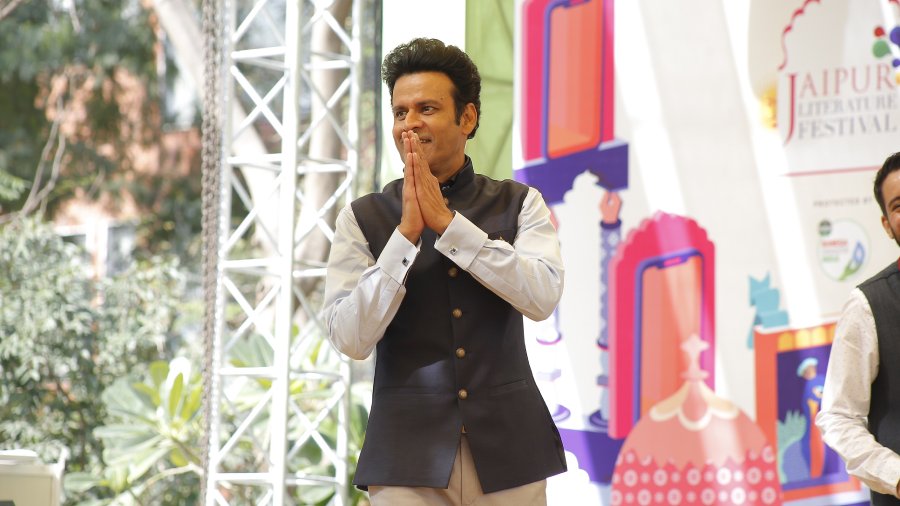The actor who changed the face of the Bollywood villain in Satya, discusses the evolution of the anti-hero in Indian, primarily Hindi, cinema with Balaji Vittal.
Manoj Bajpayee belongs to that rare group of celebrities who smell of humility that spills out of him every time he moves or speaks. The actor who brought nuance to the quintessential villain of Bollywood was in conversation with author Balaji Vittal as they traced the evolution of anti-heroes in this industry that is worth upwards of Rs 18,300 crore.
A full house greeted Bajpayee at 10 in the morning at the Jaipur Literature Festival 2022, paying no heed to the scorching sun, and he couldn’t have been speaking to anyone more significant than Vittal, who has recently written his latest book, Pure Evil: The Bad Men of Bollywood (HarperCollins India). Vittal has previously co-authored R.D. Burman: The Man, The Music, which won the National Award for Best Book on Cinema (2011) and is also the writer of Gaata Rahe Mera Dil: 50 Classic Hindi Film Songs.

Bajpayee in conversation with Balaji Vittal at the Jaipur Literature Festival 2022 (far left) and Vittal’s new book
Vittal’s Pure Evil divides the world of Bollywood villains chronologically as well as across genres. Summarised Vittal: “There are the foreigner villains who can further be divided into pre- and post-Independence, then comes Zamindars who gave birth to the dacoits, then comes the psychopaths and then the entire mafia genre and how they started small-time in films like Footpath and Kala Bazar and progressed to smuggling gold. Finally, in the 2000s we had the villains who were like superheroes, like in Dhoom. In between, you had the individual villains like the cheating friend, stepmother, dishonest employee, or wife-snatching best friends.”
Inevitably, the conversation led to Satya, directed by Ram Gopal Verma and written by Saurabh Shukla and Anurag Kashyap, which gave us the indomitable villain Bhiku Mhatre in Bajpayee and went on to win six Filmfare Awards and a National Film Award. Considered a cult film, Bollywood can clearly be divided into two eras –– pre- and post-Satya and Bajpayee threw light on his process of making the character his own.

Manoj Bajpayee essayed pivotal roles in Satya
“Actors like me, Saurabh Shukla, Kay Kay Menon came from a theatre background and had a very different definition of ‘bad guys’. Bhiku Mhatre gave me the opportunity to really showcase that definition that we completely believed in,” Bajpayee said of the iconic character who was really a dangerous villain because of how ‘emotional and vulnerable he was’. He spoke of Mhatre’s friendships, his family life, his loyalty and his thinking that stemmed straight from the heart –– everything that made him a villain not seen before, marking the advent of iconic backstories to Bollywood baddies.
Listening to Bajpayee talk about his characters is akin to a film study post-graduation class, an actor’s masterclass which tells you method acting is just one ploy of many such, that makes an actor superlative in his vocation. He wears his hometown as a talisman as he declares, “I am from Bihar and I have seen the worst street fights and real gangsters who are exactly like me and you. It could perhaps never get worse or dangerous than that.”

Manoj Bajpayee essayed pivotal roles in Gangs of Wasseypur
This simplicity is perhaps what allows him the compassion he provides his characters, however evil they may be. And this evolution of evilness in Bollywood has reflected the times we have lived in, perfectly, believes Vittal from his deep research on his book. Putting the two thoughts together, unbeknownst to him, the anti-hero has emerged as the spokesperson of the social conflicts we have encountered as Indians.
However, no one was asking ‘Gabbar kyun hasta hai?’ (Why does Gabbar laugh?), ignoring the mental condition that Gabbar may have had. “We only focused on the antagonistic behaviour and it was only in later films that they started building backstories to the characters like Shah Rukh Khan in Darr, or Nana Patekar in Agni Sakshi,” Vittal added.
One can’t talk about Indian villains without discussing Anurag Kashyap’s much-acclaimed film Gangs of Wasseypur that had Bajpayee play the iconic role of Sardar Khan. A stray comment from Anurag Kashyap wanting to make a ‘mainstream film’ but doing it his way, changed everything for Bajpayee. He decided to approach Sardar Khan similarly and fondly remembered the experience of getting a haircut from the local barber before this role.
“He just went on and on and Anurag and I didn’t tell him to stop. That’s when the journey of Sardar Khan started. He had a raw sex appeal and he just wanted sex. He would not kill that day if he found a very attractive woman on the road. He is a reluctant murderer but a very excited sex addict,” Bajpayee said of the ‘pervert’ character.
He also spoke about the kind of detailing that went into building Sardar Khan, sharing an anecdote that he firmly believes has never been spoken about in the world of films –– that Sardar Khan ages a couple of years every three scenes. “The fact that no one noticed it serves as a compliment to me. Anurag Kashyap’s sister (Anubhuti Kashyap) was an AD on the film and it was her responsibility to remind me before every shot how old Khan was in that scene,” he said.
The anti-hero has really evolved and found its own space where on recent OTT releases there are shows being built on the great area that lies between good and evil. Talking of the early ’70s and ’80s with Dev Anand and Pran facing off each other, Vittal spoke of the cheap tropes that were employed to make the villain look bad. The audience would be told whom to hate and how much to hate. But with maturity came a level-playing field for the anti-hero to wage a war against the hero.
“Maturity also meant you no longer needed to dress up your villain ridiculously to proclaim to the world that he is evil. Ajit saab is seen wearing white gloves in Yaadon ki Baraat. Which villain wears white gloves?” asked Vittal! Sartorial changes disallowing the villain to prominently stick out as a sore thumb in films was a result of this slow maturity.
On this maturity, Bajpayee urged the audience to watch his film Aks, which he believes to be the precursor to the likes of Joker from the Batman series. On one of the biggest risks of Bajpayee’s career, he spoke about the ‘role of great potential which gave the chance of defining evil’. “Evil is not just black. Defining evil is the most tedious task,” Bajpayee said.
There couldn’t perhaps be a man better suited to portray all the shades of darkness than him and getting a small peek into his deeply mindful research for every character he plays left us moved.
